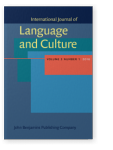Gender, shape, and sociality
How humans are special in Manambu
Many languages of the world have genders, that is, grammatical agreement classes, based on such core semantic properties as animacy, sex and humanness, and also shape. In Manambu, a language of New Guinea, nouns are assigned genders according to the sex of a human referent, and to shape and size of any other referent. Men are assigned to the masculine, and women to the feminine gender. A long tube and a large house are masculine, and a round plate and a small house are feminine. Switching gender for humans has pejorative overtones: an unusually boisterous or bossy woman can be treated as masculine, and a squat fattish man who does not display fully masculine behaviour as feminine. Classifying humans by their shape and size implies downgrading them to the level of inanimates. Gender switch also reflects social stereotypes. Feminine gender is functionally unmarked for non-humans, but not for humans. The noun du, “man” can be used as a generic term for “human being.” Linguistic Gender of humans in Manambu unequivocally reflects Social Gender relations.
References (39)
Aikhenvald, A.Y
(
2000)
Classifiers: A typology of noun categorization devices. Oxford: Oxford University Press.

Aikhenvald, A.Y
(
2004)
Gender. Article 98. In
G.E. Booij,
C. Lehmann,
J. Mugdan, &
S. Skopeteas (Eds.),
Morfologie/Morphology. Ein Handbuch zur Flexion und Wortbildung/A handbook on inflection and word formation, 2 Halbband (pp. 1031–1045). Berlin: Mouton de Gruyter.

Aikhenvald, A.Y
(
2008)
The Manambu language of East Sepik, Papua New Guinea. Oxford: Oxford University Press.

Aikhenvald, A.Y
(
2012)
Round women and long men: Shape and size in gender choice in Papua New Guinea and beyond.
Anthropological Linguistics, 54(1), 33–86.


Aikhenvald, A.Y
(
2013)
The language of value and the value of language.
Hau: A Journal of Ethnographic Theory, 3(2), 55–73.


Aikhenvald, A.Y
(
2014)
Double talk: Parallel structures in Manambu songs.
Language and Linguistics in Melanesia, 32(2), 86–109.

Aikhenvald, A.Y
(
2015a)
Classifiers: A bibliography. Oxford Bibliography Online. New York: Oxford University Press.

Aikhenvald, A.Y
(
2016)
How gender shapes the world. Oxford: Oxford University Press.


Aikhenvald, A.Y., & Green, D
(
1998)
Palikur and the typology of classifiers.
Anthropological Linguistics, 401, 429–480.

Alpher, B
(
1987)
Feminine as the unmarked gender: Buffalo girls are no fools.
Australian Journal of Linguistics, 71, 169–187.


Alvanoudi, Angeliki
2015 Grammatical gender in interaction: Cultural and cognitive aspects. Leiden: Brill.


Baron, D
(
1986)
Language and gender. New Haven: Yale University Press.

Beauvoir, S. de
(
1949)
Le deuxième sexe. Paris: Gallimard.

Chafe, W
(
2004)
Masculine and feminine in the Northern Iroquioan languages. In
N.J. Enfield (Ed.),
Ethnosyntax. Explorations in grammar and culture (pp. 99–109). Oxford: Oxford University Press.


Coates, J
(
1993)
Women, men and language. London and New York: Longman.

Corbett, G
(
1991)
Gender. Cambridge, MA: Cambridge University Press.


Corbett, G
(
2014)
Gender typology. In
G. Corbett (Ed.),
The expression of gender (pp. 87–130). Berlin: Mouton de Gruyter.

Dixon, R.M.W
(
1972)
The Dyirbal language of North Queensland. Cambridge, MA: Cambridge University Press.


Dixon, R.M.W
(
1982)
Where have all the adjectives gone? and other essays in semantics and syntax. Berlin: Mouton.


Dixon, R.M.W
(
2004)
The Jarawara language of Southern Amazonia. Oxford: Oxford University Press.

Dixon, R.M.W
(
2010)
Basic linguistic theory, Vol. 11. Oxford: Oxford University Press.

Dixon, R.M.W
(
2015)
Edible gender, mother-in-law style, and other grammatical wonders: Studies in Dyirbal, Yidiñ, and Warrgamay. Oxford: Oxford University Press.


Eckert, P., & McConnell-Ginet, S
(
2003)
Language and gender. Cambridge, MA: Cambridge University Press.


Georg, S
(
2007)
A descriptive grammar of Ket. Folkestone: Global Oriental Ltd.


Harrison, S.J
(
1990)
Stealing people’s names: History and politics in a Sepik river cosmology. Cambridge, MA: Cambridge University Press.


Hellinger, M., & Pauwels, A
(
2007)
Language and sexism. In
M. Hellinger &
A. Pauwels (Eds.),
Handbook of language and communication: Diversity and change (pp. 651–681). Berlin: Mouton De Gruyter.


Joseph, B.D., & Philippaki-Warburton, I
(
1987)
Modern Greek. London: Routledge.

Kilian-Hatz, C
(
2008)
A grammar of Modern Khwe (Central Khoisan). Cologne: Rüdiger Köppe.

McConnell-Ginet, S
(
1979)
Prototypes, pronouns and persons. In
M. Mathiot (Ed.),
Ethnology: Boas, Sapir and Whorf revisited (pp. 63–83). The Hague: Mouton.


Mills, S
(
2008)
Language and sexism. Cambridge, MA: Cambridge University Press.


Payne, J.K
(
1989)
Lecciones para el aprendizaje del idioma Ashéninca.
Série Lingüística Peruana No. 28. Yarinacocha: Instituto Lingüístico del Verano.

Rapold, C.J
(
2006)
Towards a grammar of Benchnon. PhD thesis, University of Leiden.

Romani Miranda, M.M
(
2004)
Toponimia en el Gran Pajonal con especial atención a los Topónimos de Afiliación Ashaninka. PhD dissertation. Universidad Nacional Mayor de San Marcos, Lima.

Roscoe, P.B
(
2001)
‘Strength’ and ‘sexuality’: Sexual avoidance and masculinity in New Guinea and Amazonia. In
T.A. Gregor &
D. Tuzin (Eds.),
Gender in Amazonia and Melanesia: An exploration of the comparative method (pp. 279–308). Berkeley: University of California Press.


Sasse, H.-J
(
1974)
Notes on the structure of Galab.
BSOAS, 371, 407–438.


Shepard, Jr., G
(
1997)
Noun classification and ethnozoological classification in Machiguenga, an Arawakan language of the Peruvian Amazon.
Journal of Amazonian Languages, 11, 29–57.

Speece, R
n.d.).
Angave grammar. Ukarumpa: Summer Institute of Linguistics.
Cited by (2)
Cited by 2 other publications
Her, One-Soon & Marc Tang
2020.
A Statistical Explanation of the Distribution of Sortal Classifiers in Languages of the World via Computational Classifiers.
Journal of Quantitative Linguistics 27:2
► pp. 93 ff.

This list is based on CrossRef data as of 4 july 2024. Please note that it may not be complete. Sources presented here have been supplied by the respective publishers.
Any errors therein should be reported to them.
